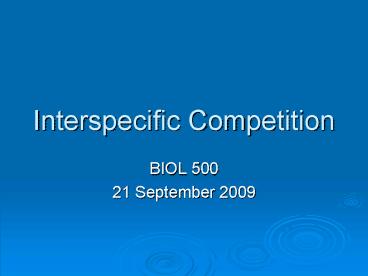Interspecific Competition PowerPoint PPT Presentation
1 / 36
Title: Interspecific Competition
1
Interspecific Competition
- BIOL 500
- 21 September 2009
2
Environmental Resource
- Consumed or utilized item in the environment,
which results in population increase if it
becomes more abundant - Food
- Space (sessile organisms)
- Sunlight
- Soil nutrients and water
- Refugia
- Etc.
3
Limitation
- It is only important to study resources which
limit rate of population growth of species using
them
4
Mechanisms of Competition
- Exploitative/Scramble
- Out-consume others for food
- Pre-empt space
- Grow over, to intercept sunlight or raining
aquatic detritus - Contest/Interference
- Drive other competitors away
- with chemicals (plants)
- with aggressive behavior (animals)
5
Principle of Competitive Exclusion
- No two species using the same limiting resource
can coexist over the long term
6
Experimental Demonstrationsof Competitive
Exclusion
- H.F. Gause1920s and 1930s
- Used two species of ciliated protozoan
(Paramecium) - P. aurelia always survived, P. caudatum always
went extinct
7
HANDOUTGauses Paramecium Studies
8
Experimental Demonstrationsof Competitive
Exclusion
- Gauses results mimicked by researchers using
short-lived organisms - Flour beetles
- Winner moisture- or temperature-dependent
- Mice
- Drosophila
- Diatoms
- Etc.
9
Figs. 10.11 10.12 pp. 171-172
32.3?C
29.1?C
10
HANDOUTTilman et al. Diatom Studies
11
Experimental Demonstrationsof Competitive
Exclusion
- Coexistence, without competitive exclusion,
occurred in some pairings
12
Lotka-Volterra Equations
- Elaborations of logistic population growth
- Logistic model assumes growth rate is reduced by
the extent to which members of a population
compete for limited resources intraspecifically - L-V model introduces the effect on resource
availability of the members of second, competing
species
13
Text p. 166
14
? and ?
- Competition coefficients
- Extent to which a member of a second species
impinges on the ability of a member of the first
to harvest resources - The higher ? and ?, the more intense the
competition between species
15
Isocline(Figs. 10.2-10.4)
- Points on the graphcombinations of N1 and N2at
which present population growth rate for one is
zero - e.g., r1(K1-N1-?N2)/K1 0
- Starting points above the isocline go down to it,
while starting points below the isocline go
upward to it
16
Fig. 10.2 p. 166
17
Isocline Example
- K1 1000, ? 0.60
- Realized r1 0 when N1 (N2??) K1
- r1 0 when
- N1 1000 and N2 0
- N1 800 and N2 333
- N1 500 and N2 833
- N1 200 and N2 1333
- N1 0 and N2 1667
18
Fig. 10.3 p. 166
19
Fig. 10.4a p. 167"Good" for species 1K1 gt K2/?
"Bad" for species 2K2 lt K1/?
20
Fig. 10.4b p. 167 "Bad" for species 1K1 lt K2/?
"Good" for species 2K2 gt K1/?
21
Fig. 10.4c p. 167 "Bad" for both speciesstable
equilibrium of species abundances
22
Fig. 10.4d p. 167 "Good" for both
speciesoutcome of competition is unpredictable
exclusion
23
Schoener (1983)
- 164 experimental tests for effects of
interspecific competition - 148 (90) showed one species affecting N and r of
another - Of 390 spp. tested, 76 showed competition
effects in at least some conditions tested - 57 always showed effects
- Butsurely NOT a random sample of study species
24
Gurevitch et al. (1992)
- Effect Size difference in biomass between
experimental species with and without
competitors, divided by pooled standard
deviations of the two treatments - 218 competition experiments
- Large effect sizes, esp. for herbivores
Fig. 10.18 p. 177
25
Niche
- Grinnell (1917)literally a subdivision of
habitat - Elton (1927)"role" in an ecosystem
- Hutchinson (1958)mathematically, an
n-dimensional hypervolume
Fig. 10.13 p. 173
26
Restating the Gaussian Principle of Competitive
Exclusion Using Hutchinsonian Terminology
- Species with high overlap in their hypervolumes
(high ? and ?) - Exclusion of one or the other
- Species with little overlap (low ? and ?)
- Resource partitioning and coexistence
27
Resource Partitioning
- Closely related or ecologically similar species
that coexist generally differ in resource use,
reducing competition - Concept stems from doctoral work of Robert
MacArthur
28
Fig. 10.14 p. 174
29
Niche Complementarity
- Two species that overlap greatly in one major
type of resource (e.g., diet) will tend to
overlap little in another (e.g., microhabitat)
30
HANDOUTCody 1968
31
HANDOUTLindeman 2000
32
Slider, Trachemys scripta
33
River cooter, Pseudemys concinna
34
Ouachita map turtle, Graptemys ouachitensis
35
Mississippi map turtle, Graptemys
pseudogeographica
36
Smooth Softshell, Apalone mutica

